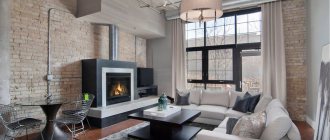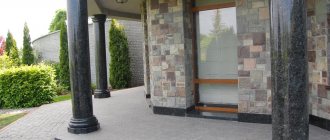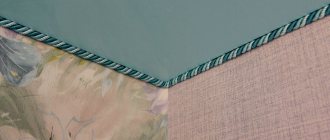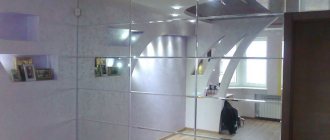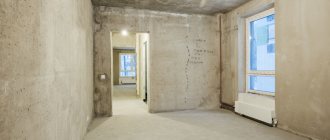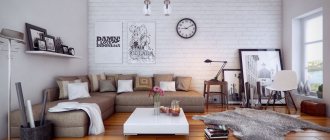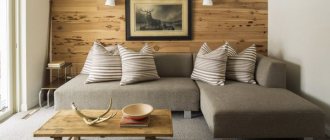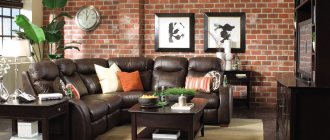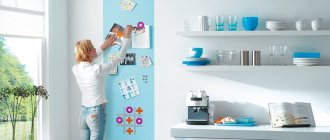Phytodesign is an important element of the overall interior concept. It emphasizes the chosen style and makes the room more comfortable. One of the tools for such design are phytowalls - vertical structures with live or artificial plants installed on them. Phytowalls can be composed of different types of plants, moss, or they can be mixed with each other. Phytowalls can be created in a room of any size.
What is a green wall
Landscaping is a partition or simply a vertical object. It is made from living plants of climbing and bush varieties. The composition is formed using holding structures. The frame of these is built strong and stable, since the finished decor will have considerable weight.
Hall with a corner living wall made of hanging plant stems Source ecosoil.ru
Vertical gardening in a house or apartment has several functions:
- suppresses noise (plant leaves are able to retain sound waves, preventing them from passing into other rooms;
- equips the room with oxygen (plants clean the air of carbon dioxide and release oxygen in return);
- it looks beautiful and accepts dust (its small particles are attached to the leaves, leaving the furniture almost clean);
- saves space in the room (plants are planted in one location, so your window sills and floors will remain free);
- in hot weather, it cools the room and increases its humidity (this occurs due to evaporation);
- has a zoning effect (with the help of a vertical garden you can divide one spacious room into two. Relevant for a studio apartment or kitchen-living room);
- allows you to hide defects in walls and ceilings, visually aligns the room.
In order for the wall to always be beautiful and lush, it must be properly maintained. Therefore, when selecting plants, be sure to consider what conditions they need. It is advisable to select varieties that are less capricious or require the same care.
Homemade plant paintings
In addition to paintings from modules, homemade “canvases” are popular, based on a wooden frame, plywood bottom and a metal mesh with a fine mesh as a limiter. The bottom is stuffed onto the frame, a thick polyethylene film is used as a waterproofing material, and perlite is added to the soil for planting. To protect against spillage of the substrate before the root system of the seedlings grows, agrotextiles can be nailed on top of the soil, in front of the mesh, and slits can be made in the cells under the seedlings. If moss (sphagnum) is used as a substrate, only a mesh is sufficient.
Plants are planted according to the chosen plot. If it is just an abstraction, several accents are made due to bright colors or sizes, and the main canvas is filled with a mass of small leaves. In order for the root system to strengthen, the frame must stand horizontally for at least two weeks, after which it can be hung. After hanging, watering as such is reduced to spraying. Thanks to abundant initial watering, perlite accumulates a large amount of moisture and subsequent spraying is sufficient to maintain an optimal balance.
Selection of plants for vertical decoration and method of cultivation
When choosing vegetation for your home garden, you first need to decide on the planting method. Indeed, for many indoor crops this factor plays an important role. Can be planted using regular flower soil (sold in gardening stores) and hydroponics.
Floral decorative wall made from different varieties of indoor plants Source dekormyhome.ru
The first option is the most popular; it is the usual habitat for indoor plants. Through the soil, the flowers will receive a sufficient amount of nutrients. But this planting option has one drawback - if the volume of planted plants is large, then such soil will need to be changed frequently (3-4 times a year). This is due to the fact that over time the vegetation will absorb all the useful elements and gradually begin to die.
The second option is hydroponics. It involves placing the root system of plants in a special substrate. The most optimal is expanded clay in combination with sphagnum moss. The first ensures normal access of oxygen, the second retains moisture.
Green wall in the house as a partition for zoning Source pinterest.ru
Living wall plants are divided into three groups.
Ideally suited plants
They have a high survival rate. In 90% of cases they germinate even after several transplants.
- Scindapsus (optimal temperature for growth is 15-18 degrees, but not less than 12. Requires humidity and bright lighting without direct sunlight.
- Agloonema. It has large oblong leaves, is thermophilic, the air temperature should be at least 18 degrees. The plant grows well in partial shade and requires frequent spraying, as it prefers up to 80% humidity. During active growth, you need to feed the agloonema with mineral fertilizer in the form of a solution.
- Monstera. It is easy to grow as it does not require special care. Grows at temperatures not lower than 12 degrees. Bright diffused light or even partial shade is suitable for lighting. They need regular fertilization with minerals. Its main property is the enrichment of the room with oxygen.
- Maranta. This plant is notable for the color of its leaves. The plant is considered heat-loving, so the optimal temperature is 22-24 degrees. It grows in partial shade, but direct exposure to sunlight should be avoided.
Plants that suit well
This vegetation is well suited for landscaping vertical surfaces, but is more demanding to care for.
- Spathiphyllum. It grows at 22-23 degrees, and in winter at 15 degrees. Requires diffused bright lighting. Considered to be tolerant of dry air, but requires frequent misting.
- Dracaena. Grows at air temperatures not lower than 12 degrees. Feels good in bright, diffused light. Dracaena needs to be fed once every two weeks with liquid mineral fertilizers. A well-groomed plant has beneficial properties and has a beneficial effect on the body. Helps older people cope more easily with summer heat and pressure changes.
Fragments of a green wall in the living room Source dizainvfoto.ru
Plants that are less commonly used for vertical gardening
- Anthurium. Has bright red inflorescences. These flowers stay on the plant stems for only a couple of weeks. Therefore, you can choose varieties so that flowering is continuous at least during a certain season. Growing at moderate temperatures - not lower than 15 degrees. In winter it loves bright light. It is necessary to spray the leaves twice as often, otherwise they will lose their color.
- Guzmania. A thermophilic plant, it develops well at a temperature of 20-25 degrees. Very demanding on air humidity. Therefore, daily spraying cannot be avoided. This plant must be grown in partial shade and high humidity. Regular spraying will be required.
All these plants can be combined with each other to create a living wall. The main thing is not to forget the rules for caring for each of them. It is advisable to start all care from the bottom up (loosening the soil, fertilizing, watering; wiping the leaves from dust, spraying them with settled water at room temperature).
On a note! To design a vertical garden in your home, it is recommended to contact a phyto-designer. It will help you decide on the size of the decor for each specific room.
Decorative living wall of different plants above the stairs in a two-story private house Source dekormyhome.ru
Unfinished green wall on the wall, decoration using hanging structure Source market.sakh.com
Advantages of phytowalls made from artificial plants
Whether it is the phytodesign of an ordinary city apartment or the landscaping of an office, such vertical structures are chosen due to the fact that they do not require careful maintenance. However, this is not their only advantage. Phytowalls made from artificial plants Treez Collection:
- Significantly save internal space. If they are used for zoning, then they take up less space than partitions. If they are more needed for placing plants, then here they have an advantage - they are more compact and more convenient than many pedestals and containers with flower arrangements.
- Do not require careful care. Artificial plants do not need regular watering. They do not need to maintain a certain temperature regime, apply fertilizers and growth stimulants, or install additional lighting to extend daylight hours. Such a phytowall will look great anyway.
- Does not place much additional load on the floor or vertical surface. Flowers in such structures do not grow over time, do not become heavy, and do not require sanitary or decorative pruning.
- Quick to install and mobile. Phytowalls are often made collapsible; if necessary, they can be easily dismantled and transported to another place. They can also be collected temporarily, for example, to decorate a large room in which some kind of mass event such as a conference is taking place.
- They are distinguished by a high level of environmental safety, as they are made of high-quality materials.
Treez brand artificial plants are durable and do not lose their attractiveness for a long time. Such flowers can be kept in a dry room, and their leaves will not turn yellow from lack of moisture or abundance of sunlight.
Nuances of creating a green wall and tips
Use our tips to organize a green wall in your space. Consider its functionality and some important nuances:
- To organize a green vertical garden, use a wall that does not bear a functional load.
- Choose a frame that can support the weight of the flowers. Moreover, the structure must be positioned so that it holds securely.
- To prevent water from leaking onto the wall after watering, you need to attach a plastic panel to the end of the retaining structure. It will prevent swelling from water.
- To avoid watering the vegetation too often, you can attach pieces of rags to each plant. They are regularly soaked with water, from where the plant receives moisture.
- An irrigation system is also suitable for watering. It is a plastic tube through which water slowly rises and drips through holes into the ground.
- For a house or apartment, you can choose a ready-made vertical living wall. It will cost more than selecting each plant individually, but it will come with care instructions.
Please note that similar growing conditions for all plants make caring for them easier.
Vertical garden with a beautiful symmetrical pattern Source pinterest.ru
Why you should order plants for artificial vertical gardening from us
Our trading company offers artificial plants in large and small wholesale. Each flower is a botanically accurate copy of a real plant, practically indistinguishable from the original - thanks to careful coloristic elaboration. For their production, high-quality polymer materials are used that do not emit harmful substances and do not cause allergies, and even fabric with natural silk for the petals of some flowers.
Our sales area offers more than a thousand varieties of artificial plants at affordable prices. For large order amounts, customers are given an individual discount. Customers can also choose a convenient payment and delivery method.
Advantages and disadvantages
In addition to the fact that a vertical green wall takes up little space and has a unique landscaping effect, several more advantages can be identified:
- Air quality improves. This works provided that the plants are carefully monitored and care requirements are followed. The room is enriched with oxygen, especially if tropical plants grow in the house.
- Unique design. A living wall in a living space looks impressive and catches the eye. Therefore, the room is transformed significantly. This effect quickly enlivens any space.
- A plant wall helps save thermal energy. After all, a large wall tends to accumulate optimal temperature around itself.
The disadvantages of landscaping include:
- the need to constantly refresh and feed plants;
- you need to choose plant varieties of approximately the same size;
- it is necessary to constantly care for the leaves (remove dust).
In general, caring for green garden vegetation at home is not difficult.
Fluffy living wall in the house from different indoor plants Source roomester.ru
Advantages
Of course, plastic or polymer greenery will not give you the aroma of real nature, nor will it delight you with an unexpectedly appeared flower bud, but it has certain advantages over living ones:
- Virtually no maintenance is required other than dusting.
- The lighting that fresh flowers or ferns require is also not needed here.
- You can combine the most incompatible types of flowers, ferns or moss.
- You will always see a green and not a fading wall.
- The weight of the structure is less than when using natural materials.
- There are no costs for purchasing fertilizers.
- No maintenance is required for such walls - living wall irrigation systems require regular cleaning.
- You will definitely not have allergic reactions, which is possible if the greens are alive.
- You select the sizes as you wish and price will not be the most important factor.
The only downside is that the composition will be artificial. Against the backdrop of advantages, this point is no longer so relevant.
Tips for creating a green wall in your home
To make your landscaping look even more interesting, use a few design tips:
- Create patterns and ornaments on such a wall. This can be achieved by using plants with leaves of different shades of green.
- Fill the void under the stairs in two-story homes. The hall will look impressive and fresh this way.
- Outdoor plants can also be used for vertical gardening. Ivy will feel great in the home. But care is important for him.
- The green wall can be recessed into a specially prepared niche made of MDF or lining. This approach will give the atmosphere neatness.
Everyone can use different vertical decor designs for decoration. For example, make landscaping with breaks along the wall or plant plants around columns in a hallway with high ceilings.
Fashionable design ideas
It is not enough to simply plant plants in pots and care for them according to the recommendations. You can try out several interesting ideas that will look good in modern interior solutions.
Landscaping in an open niche of a wardrobe
A beautiful green wall for a small living room will fit comfortably in the bedside table of a wardrobe or other furniture set. If there is an internal shelf from the TV left, then you can also fill it with plants.
A small beautiful living wall against a white background for a living room set Source ecosten.rf
Multi-layer garden wall
It turns out to be a very impressive spectacle. This design consists of several varieties of plants that differ in shade. This composition looks good both in good light and in partial shade.
Green walls in a house with a non-standard texture Source sadkoltso.ru
Sloping landscaping at the doorway
This decor is placed in two identical double-sided niches. Plants are arranged in small pots in rows. It is advisable to plant plants of the same variety in such niches. Design in layers is allowed.
Living green garden in double-sided niches near the doorway Source s30086307251.mirtesen.ru
Implementation of a zone near the TV
In a spacious, bright room, you can use a living garden to decorate the wall on which the TV hangs. To do this, you will need two niches with a regulatory mechanism. Plants are displayed on their shelves in long trays. The base for the wall itself is located on both sides of the TV.
Decorating a wall with a living vertical garden on both sides Source s30086307251.mirtesen.ru
Design ideas
Plantogram
The living picture has the form of a plant canvas with small flowers. It occupies part of the living room wall. Succulent plants are used to create a plantogram. The main theme of the paintings is still lifes.
Big beats
Plants with large leaves are used to create a living wall. It is better to place such structures in niches. It creates a feeling of penetration of vegetation from the street and closeness to nature. Designs of this type always occupy a central place in the interiors of premises.
Japanese grace
A Japanese-style living wall is made in the recess of a window. The composition consists of several branches of vegetation of the same decorative type. They are used in interiors designed in a minimalist style. They create the feeling of greenery looking through the window and emphasize the laconic design of the room.
Green pockets
Ceramic pots, plastic or wooden containers are used in the design for planting plants. Each of them houses one or more plants. Modules with them are placed on the frame in a certain order, creating a composition.
Merging fragments
Modules with plants are placed on the wall in scattered fragments. In such a composition it is easy to update the panels and change the appearance of the wall.
Moss panels
Used for installation in bathrooms.
Live waves
The idea is suitable for decorating surfaces whose integrity is destroyed by door and window openings. Several types of plants have lines that create intricate patterns.
Inclined installations
Containers or pots with plants are installed in double-sided niches located at a slight angle. To create a living wall, only one variety of plants is used.
Green columns
They consist of climbing plants that are planted in pots and allowed to trail along a cone-shaped frame. The most common places to install green columns are: bathroom, kitchen, hall. This type of installation is best suited to Mediterranean-style interiors.
Ornament of different varieties
Walls made from several plant options that differ in color look very impressive. When they are ripe, a peculiar structural pattern is obtained. Typically, small areas of landscaping are used for such purposes.
Interesting pattern on a green wall made of plants Source flowall.ru
